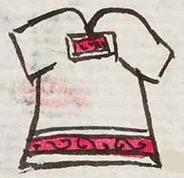Huipillan (Mdz13v)
This simplex glyph of a huipilli (blouse) doubles as the glyph for the place name Huipillan. This blouse is primarily white with red and black accents. At the base of the v-neck, over the chest, is a rectangle with a white frame and a slightly smaller red rectangle inside. This red triangle has some black designs that are difficult to make out. At the bottom of the blouse, which is tunic-length, there is a narrow, horizontal black stripe, and below that a wider red stripe with curling black designs across it. The locative suffix (-tlan, which goes to -lan before the stem ending in the letter l, -huipil).
Stephanie Wood
The double l in Spanish had a different sound from the single l, so many double ll's went to a single l in Nahuatl. But in Nahuatl, as a rule, the double l was pronounced the same as a single l. The -lan suffix here does not necessarily imply abundance.
Tunics (called huipiles in Spanish) could be made for men or women. They were woven on backstrap looms. One of the garments called a huipilli, below right, is covered with yellow feathers, and was probably a male warrior's tunic. Women's tunics very typically had the reinforcing triangle at the bottom of the v-neck. The designs of women's tunics could also very considerably, as other iconographic examples in this collection will show.
And the Lienzo de Tlaxcala reveals something of the considerable diversity of designs of huipiles for women.
Stephanie Wood
huipilan_puo
Huipillan, pueblo
Stephanie Wood
c. 1541, or by 1553 at the latest
Stephanie Wood
blouses, clothing, textiles, blusas, ropa, huipiles, nombres de lugares

huipil(li), woman's blouse, https://nahuatl.wired-humanities.org/content/huipilli
-tlan (locative suffix), place of, https://nahuatl.wired-humanities.org/content/tlan
"Huipil Place" [Frances Karttunen, unpublished manuscript, used here with her permission.]
"Where There Are Many Huipiles" (Berdan and Anawalt, 1992, vol. 1, p. 189)
"El Lugar del Huipil"
Stephanie Wood
Codex Mendoza, folio 13 verso, https://digital.bodleian.ox.ac.uk/objects/2fea788e-2aa2-4f08-b6d9-648c00..., image 37 of 188.
The Bodleian Libraries, University of Oxford, hold the original manuscript, the MS. Arch. Selden. A. 1. This image is published here under the UK Creative Commons, “Attribution-NonCommercial-ShareAlike 3.0 License” (CC-BY-NC-SA 3.0).


